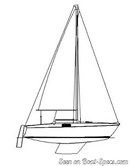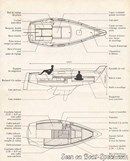Kelt 6.20 Fin keel
Sailboat specifications
The Kelt 6.20 is a 20’4” (6.2m) cruising sailboat designed by Philippe Harlé (France). She was built between 1974 and 1984 by Kelt (France). The Fin keel version adopts a classical fin configuration, the easiest option to provide a low center of gravity.
Kelt 6.20's main features
- Model
- Kelt 6.20
- Version
- Fin keel
- Hull type
- Monohull
- Category
- Coastal cruising sailboat
- Sailboat builder
- Sailboat designer
- Country
- France
- Construction
- GRP (glass reinforced polyester):
Single skin fiberglass polyester - Number of hulls built
- About 1300
- First built hull
- 1974
- Last built hull
- 1984
- Appendages
- Keel : fin without bulb
- Helm
- Single tiller
- Rudder
- Single transom hung rudder
- Unsinkable
- No
- Trailerable
- Yes
- Former French navigation category
- 3
- Standard public price ex. VAT (indicative only)
- N/A €
Kelt 6.20's main dimensions
- Overall length
- 23’ 1”7.05 m
- Hull length
- 20’ 4”6.2 m
- Waterline length
- 17’ 1”5.2 m
- Beam (width)
- 8’ 1”2.48 m
- Draft
- 3’ 6”1.06 m
- Mast height from DWL
- 28’ 8”8.75 m
- Light displacement (MLC)
- 2260 lb1025 kg
- Ballast weight
- 772 lb350 kg
- Ballast type
- Cast iron
- French customs tonnage
- 2.95 Tx
Kelt 6.20's rig and sails
- Upwind sail area
- 255 ft²23.7 m²
- Downwind sail area
- 445 ft²41.3 m²
- Mainsail area
- 95 ft²8.8 m²
- Genoa area
- 160 ft²14.9 m²
- Solent area
- 114 ft²10.6 m²
- Jib area
- 93 ft²8.6 m²
- Stormjib area
- 30 ft²2.8 m²
- Symmetric spinnaker area
- 350 ft²32.5 m²
- IiFore triangle height (from mast foot to fore stay top attachment)
- 24’ 2”7.38 m
- JiFore triangle base (from mast foot to bottom of forestay)
- 8’ 6”2.6 m
- PiMainsail hoist measurement (from tack to head)
- 21’ 4”6.5 m
- EiMainsail foot measurement (from tack to clew)
- 7’ 11”2.4 m
- Rigging type
- Sloop Marconi masthead
- Mast configuration
- Deck stepped mast
- Rotating spars
- No
- Number of levels of spreaders
- 1
- Spreaders angle
- 0 °
- Spars construction
- Aluminum spars
- Standing rigging
- 1x19 strand wire continuous
Kelt 6.20's performances
- Upwind sail area to displacementiThe ratio sail area to displacement is obtained by dividing the sail area by the boat's displaced volume to the power two-thirds.
The ratio sail area to displacement can be used to compare the relative sail plan of different sailboats no matter what their size.
Upwind: under 18 the ratio indicates a cruise oriented sailboat with limited performances especially in light wind, while over 25 it indicates a fast sailboat. - 251 ft²/T23.31 m²/T
- Downwind sail area to displacementiThe ratio sail area to displacement is obtained by dividing the sail area by the boat's displaced volume to the power two-thirds.
The ratio sail area to displacement can be used to compare the relative sail plan of different sailboats no matter what their size. - 437 ft²/T40.63 m²/T
- Displacement-length ratio (DLR)iThe Displacement Length Ratio (DLR) is a figure that points out the boat's weight compared to its waterline length. The DLR is obtained by dividing the boat's displacement in tons by the cube of one one-hundredth of the waterline length (in feet).
The DLR can be used to compare the relative mass of different sailboats no matter what their length:
a DLR less than 180 is indicative of a really light sailboat (race boat made for planning), while a DLR greater than 300 is indicative of a heavy cruising sailboat. - 206
- Ballast ratioiThe Ballast ratio is an indicator of stability; it is obtained by dividing the boat's displacement by the mass of the ballast. Since the stability depends also of the hull shapes and the position of the center of gravity, only the boats with similar ballast arrangements and hull shapes should be compared.
The higher the ballast ratio is, the greater is the stability. - 34 %
- Critical hull speediAs a ship moves in the water, it creates standing waves that oppose its movement. This effect increases dramatically the resistance when the boat reaches a speed-length ratio (speed-length ratio is the ratio between the speed in knots and the square root of the waterline length in feet) of about 1.2 (corresponding to a Froude Number of 0.35) . This very sharp rise in resistance, between speed-length ratio of 1.2 to 1.5, is insurmountable for heavy sailboats and so becomes an apparent barrier. This leads to the concept of "hull speed".
The hull speed is obtained by multiplying the square root of the waterline length (in feet) by 1.34. - 5.53 knots
Kelt 6.20's auxiliary engine
- Engine(s)
- 1 outboard engine
Kelt 6.20's accommodations and layout
- Cockpit
- Closed aft cockpit
- Berth(s)
- 4
- Maximum headroom
- 4’ 8”1.42 m
Kelt 6.20's saloon
- Maximum headroom
- 4’ 4”1.3 m
- Saloon table length
- 2’ 6”0.77 m
- Saloon table width
- 1’ 10”0.55 m
- Berth length
- 6’ 6”1.97 m
- Berth width (head/elbows/knees/feet)
- 1’ 7”0.5 m / 1’ 7”0.5 m / 1’ 7”0.5 m / 1’ 7”0.5 m
Kelt 6.20's fore cabin
- Maximum headroom
- 3’ 10”1.17 m
- Berth length
- 5’ 11”1.8 m
- Berth width (head/elbows/knees/feet)
- 5’ 2”1.57 m / 3’ 8”1.13 m / 2’ 4”0.69 m / 0’ 10”0.25 m





Kelt 6.20 interior and accommodations - - 4/4
Picture extracted from the commercial documentation © Kelt
Picture extracted from the commercial documentation © Kelt
Similar sailboats that may interest you:
Sailboats
First built hull
Hull length
1982
23’ 7”7.2 m
1985
23’ 7”7.2 m
1982
23’ 7”7.2 m
1966
23’ 4”7.1 m
1995
21’ 6”6.55 m
1985
22’ 7”6.9 m
1976
19’ 8”6 m
1978
19’ 8”6 m
1982
25’ 4”7.7 m
1970
21’ 8”6.6 m
1973
20’ 4”6.2 m
1977
23’ 7”7.2 m
1978
21’ 6”6.55 m
1979
19’ 8”6 m
1979
24’ 11”7.6 m